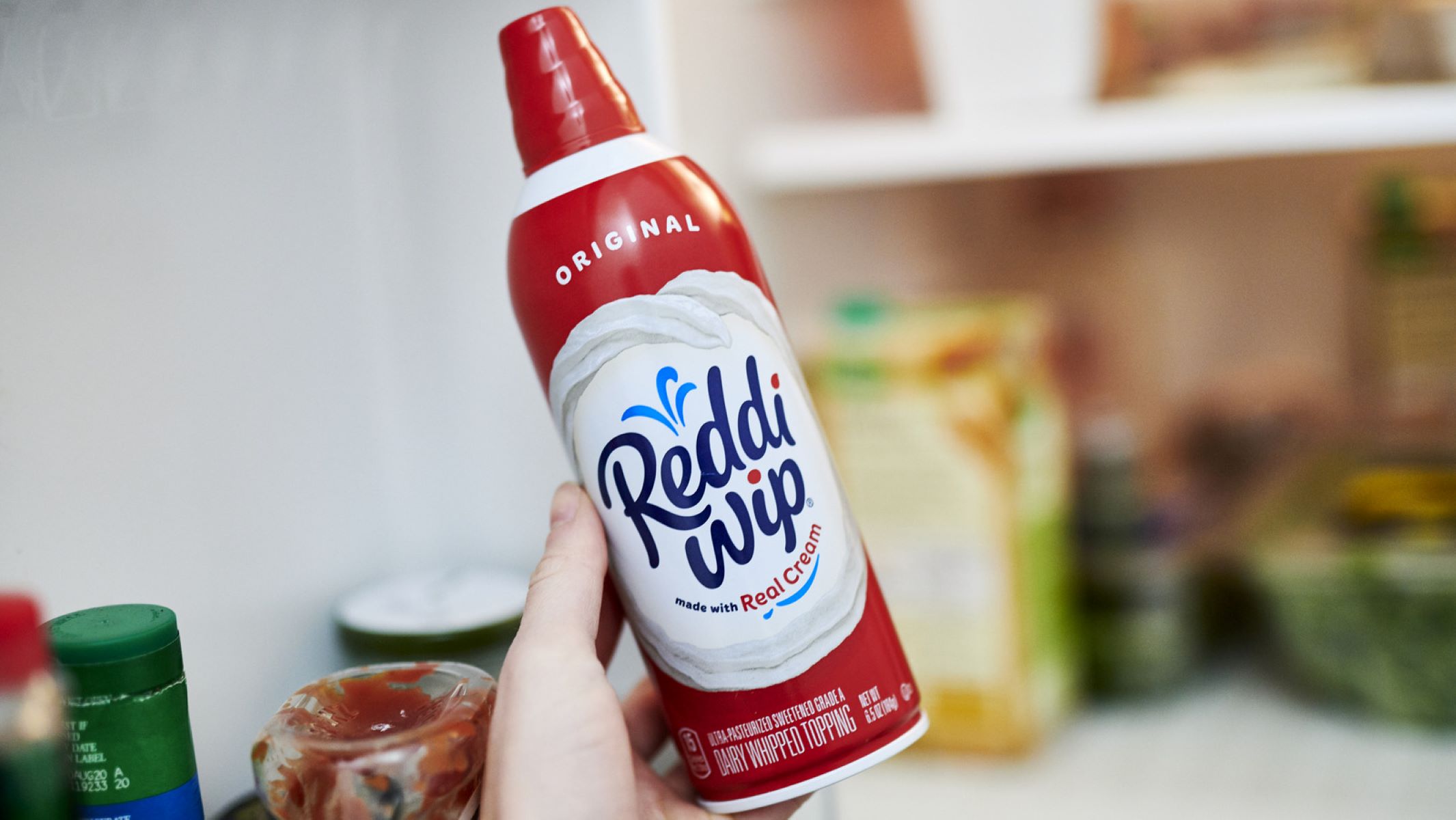Home>Food and Cooking>The Surprising Reason Reddi-wip Stops Working After A Few Days


Food and Cooking
The Surprising Reason Reddi-wip Stops Working After A Few Days
Published: February 8, 2024
Discover the surprising reason why Reddi-wip stops working after a few days. Get expert tips and insights on food and cooking. Unlock the secret now!
(Many of the links in this article redirect to a specific reviewed product. Your purchase of these products through affiliate links helps to generate commission for Regretless.com, at no extra cost. Learn more)
Table of Contents
Introduction
Have you ever reached for a can of Reddi-wip in the fridge, only to find that it has lost its signature fluffiness after just a few days? It's a common frustration for many of us, but have you ever wondered why this happens? In this article, we're going to delve into the science behind Reddi-wip and explore the surprising reason why it seems to stop working so quickly.
Reddi-wip, the beloved whipped cream in a can, is a staple in many households, adding a delightful dollop of creamy goodness to desserts, hot drinks, and more. However, despite its convenience and delicious taste, Reddi-wip can sometimes fall short of our expectations when it comes to shelf life. Understanding the factors that contribute to its limited longevity can shed light on how to maximize its freshness and ensure that it maintains its fluffy texture for as long as possible.
In the sections that follow, we'll uncover the intricate science behind Reddi-wip, examining the role of propellants, the impact of temperature, and the importance of storage. By gaining a deeper understanding of these factors, you'll be equipped with the knowledge to extend the lifespan of your Reddi-wip and savor its creamy perfection for longer. So, let's embark on this fascinating exploration into the world of Reddi-wip and unveil the secrets behind its shelf life.
The Science Behind Reddi-wip
The allure of Reddi-wip lies in its ability to transform liquid cream into a fluffy, delectable topping at the press of a button. But what exactly makes this possible? The secret lies in the science of gas solubility and pressure.
Reddi-wip contains a combination of heavy cream, sugar, and vanilla, all of which are held under pressure in a canister. However, the key to its signature fluffiness lies in the incorporation of nitrous oxide (N2O) as a propellant. Nitrous oxide is a gas that dissolves readily in the fatty cream mixture, thanks to its non-polar nature. This dissolution occurs under high pressure within the can, allowing the gas to become dispersed within the liquid cream.
Upon dispensing, the sudden release of pressure causes the dissolved nitrous oxide to rapidly expand, creating bubbles and aerating the cream. This process effectively transforms the liquid cream into a light, airy foam, resulting in the characteristic texture of Reddi-wip. The presence of fat in the cream further stabilizes the foam, ensuring that it maintains its structure and fluffiness.
The role of nitrous oxide extends beyond its ability to aerate the cream; it also serves as a preservative. Nitrous oxide inhibits the growth of spoilage microorganisms, thereby extending the shelf life of Reddi-wip. This dual functionality of nitrous oxide as both a propellant and a preservative underscores its crucial role in the science behind Reddi-wip.
In essence, the science behind Reddi-wip hinges on the principles of gas solubility, pressure differentials, and the interplay of ingredients to create a delightful, fluffy topping. Understanding this intricate process illuminates the delicate balance of factors that contribute to the unique qualities of Reddi-wip and, ultimately, its shelf life.
Factors Affecting Reddi-wip's Shelf Life
Several factors play a pivotal role in determining the shelf life of Reddi-wip, influencing its texture, flavor, and overall quality over time. Understanding these factors is essential for maximizing the longevity of this beloved whipped cream product.
The Role of Propellants
As mentioned earlier, nitrous oxide serves as a crucial component in Reddi-wip, contributing to both its texture and preservation. The presence of nitrous oxide not only aerates the cream upon dispensing but also inhibits the growth of spoilage microorganisms. However, over time, the dissipation of nitrous oxide from the cream can lead to a loss of fluffiness and a decrease in preservative effects, ultimately impacting the shelf life of Reddi-wip.
The Impact of Temperature
Temperature exerts a significant influence on the stability and freshness of Reddi-wip. Exposure to elevated temperatures can accelerate the breakdown of the cream's structure, causing it to deflate and lose its airy texture. Additionally, fluctuations in temperature, such as repeated exposure to room temperature after refrigeration, can expedite the deterioration of Reddi-wip. It is important to store Reddi-wip consistently in the refrigerator to mitigate the adverse effects of temperature on its shelf life.
Read more: Shocking: Dog Vomits Days After Spaying!
The Importance of Storage
Proper storage is paramount in preserving the quality of Reddi-wip. When stored in the refrigerator at the recommended temperature, Reddi-wip is shielded from the detrimental impact of heat and light, thereby prolonging its freshness. Additionally, ensuring that the can is tightly sealed after each use prevents the ingress of air, which can compromise the stability of the cream and hasten its degradation. By prioritizing appropriate storage practices, consumers can extend the shelf life of Reddi-wip and enjoy its delightful fluffiness for an extended duration.
In essence, the interplay of propellants, temperature, and storage practices collectively dictates the shelf life of Reddi-wip. By recognizing the significance of these factors, individuals can adopt strategies to optimize the longevity of Reddi-wip, allowing them to relish its creamy perfection for an extended period.
The Role of Propellants
The presence of propellants, particularly nitrous oxide, in Reddi-wip plays a pivotal role in shaping its texture and preserving its freshness. Nitrous oxide, a gas known for its solubility in fatty substances, serves a dual purpose in the context of Reddi-wip. Upon dispensing, the sudden release of pressure causes the dissolved nitrous oxide to expand rapidly, creating bubbles and aerating the cream. This process results in the transformation of the liquid cream into a light, airy foam, which defines the characteristic texture of Reddi-wip. The incorporation of nitrous oxide as a propellant is fundamental to the creation of the delightful, fluffy topping that consumers have come to love.
Beyond its role in aerating the cream, nitrous oxide also functions as a preservative within Reddi-wip. By inhibiting the growth of spoilage microorganisms, nitrous oxide contributes to extending the product's shelf life. This preservation effect is particularly significant in ensuring that Reddi-wip maintains its quality and safety for consumption over time.
However, as with any preservative, the efficacy of nitrous oxide diminishes gradually. As Reddi-wip is dispensed and the canister is opened, the concentration of nitrous oxide within the cream decreases, leading to a reduction in its preservative effects. Consequently, the gradual dissipation of nitrous oxide contributes to the limited shelf life of Reddi-wip, as the cream becomes more susceptible to microbial spoilage and textural changes.
It is important to recognize the delicate balance between the aerating and preservative functions of nitrous oxide in Reddi-wip. While it contributes to the initial fluffiness and longevity of the product, the gradual loss of nitrous oxide over time necessitates mindful consumption and storage practices to maximize the enjoyment of Reddi-wip.
In essence, the role of propellants, particularly nitrous oxide, underscores the intricate interplay between texture, preservation, and shelf life in the context of Reddi-wip. By understanding the multifaceted impact of propellants, consumers can appreciate the scientific foundations that underpin the beloved whipped cream product and make informed choices to optimize its freshness and quality.
The Impact of Temperature
Temperature exerts a profound influence on the stability and quality of Reddi-wip, significantly impacting its shelf life and overall freshness. The delicate structure of Reddi-wip, characterized by its light and airy texture, is particularly susceptible to the effects of temperature variations. Understanding the nuanced impact of temperature is essential for preserving the integrity of Reddi-wip and maximizing its longevity.
Exposure to elevated temperatures poses a considerable threat to the stability of Reddi-wip. When subjected to heat, the cream within the canister becomes more prone to structural breakdown, leading to a loss of fluffiness and a compromised texture. The integrity of the air bubbles that give Reddi-wip its characteristic lightness is particularly vulnerable to heat, as higher temperatures can cause these bubbles to collapse, resulting in a denser and less appealing consistency.
Furthermore, fluctuations in temperature can exacerbate the degradation of Reddi-wip. For instance, if Reddi-wip is repeatedly exposed to room temperature after being refrigerated, the ongoing shift between cold and ambient conditions can expedite the deterioration of the product. This fluctuation disrupts the delicate balance of the cream's structure, hastening the loss of its airy texture and diminishing its overall quality.
To mitigate the adverse effects of temperature, it is imperative to prioritize consistent refrigeration. Storing Reddi-wip at the recommended temperature in the refrigerator shields it from the detrimental impact of heat, preserving its delightful fluffiness and ensuring a longer shelf life. By maintaining a stable and cool environment, consumers can safeguard the integrity of Reddi-wip, enhancing their enjoyment of this beloved whipped cream product.
In essence, the impact of temperature on Reddi-wip underscores the critical role of proper storage in preserving its texture and quality. By recognizing the susceptibility of Reddi-wip to temperature variations and embracing diligent refrigeration practices, individuals can prolong the freshness and enjoyment of this beloved culinary delight.
The Importance of Storage
Proper storage is paramount in preserving the quality and extending the shelf life of Reddi-wip. The impact of storage conditions, including temperature and exposure to light, directly influences the stability and freshness of this beloved whipped cream product. By understanding the significance of storage and implementing best practices, consumers can optimize the longevity of Reddi-wip and savor its delightful fluffiness for an extended duration.
One of the primary considerations in storage is temperature control. Reddi-wip should be consistently stored in the refrigerator at the recommended temperature to mitigate the adverse effects of heat and maintain its optimal texture. Refrigeration not only slows down the natural degradation of the cream but also helps to preserve the integrity of the air bubbles that give Reddi-wip its characteristic lightness. By adhering to refrigeration guidelines, consumers can safeguard the delicate structure of Reddi-wip and prolong its shelf life.
Furthermore, the impact of light exposure on Reddi-wip should not be overlooked. Ultraviolet (UV) light, whether from sunlight or artificial sources, can accelerate the deterioration of the cream, leading to textural changes and a reduction in quality. As such, storing Reddi-wip in opaque or non-transparent containers, such as the original canister, shields it from the detrimental effects of light exposure, contributing to its longevity and preserving its delightful fluffiness.
Additionally, ensuring that the canister is tightly sealed after each use is essential for maintaining the freshness of Reddi-wip. By minimizing exposure to air, which can compromise the stability of the cream, consumers can effectively extend the shelf life of Reddi-wip and retain its appealing texture over time.
In essence, the importance of storage in preserving Reddi-wip's quality cannot be overstated. By prioritizing consistent refrigeration, protecting it from light exposure, and sealing the canister diligently, consumers can maximize the enjoyment of Reddi-wip and indulge in its creamy perfection for an extended period. Understanding the pivotal role of storage empowers individuals to make informed choices that optimize the freshness and longevity of this beloved whipped cream product.
Conclusion
In conclusion, the shelf life of Reddi-wip is influenced by a confluence of factors, each playing a pivotal role in shaping its texture, flavor, and overall quality. The intricate science behind Reddi-wip, rooted in the interplay of propellants, temperature, and storage practices, underscores the delicate balance required to preserve its delightful fluffiness and extend its longevity.
The role of propellants, particularly nitrous oxide, serves as a cornerstone of the science behind Reddi-wip. Not only does nitrous oxide contribute to the initial aeration and texture of the cream, but it also acts as a preservative, inhibiting the growth of spoilage microorganisms. However, the gradual dissipation of nitrous oxide over time underscores the need for mindful consumption and storage to maximize the enjoyment of Reddi-wip.
Temperature emerges as a critical factor in determining the stability and freshness of Reddi-wip. The susceptibility of Reddi-wip to heat-induced structural breakdown necessitates consistent refrigeration to preserve its delightful texture. Fluctuations in temperature further underscore the importance of maintaining a stable environment to mitigate the adverse effects on Reddi-wip's quality.
Proper storage practices, encompassing refrigeration, protection from light exposure, and diligent canister sealing, are instrumental in prolonging the shelf life of Reddi-wip. By adhering to these best practices, consumers can optimize the freshness and quality of Reddi-wip, ensuring that it maintains its delightful fluffiness for an extended duration.
Ultimately, the longevity of Reddi-wip hinges on a harmonious combination of scientific principles and mindful consumption and storage practices. By gaining a deeper understanding of the factors influencing its shelf life, individuals can maximize the enjoyment of this beloved whipped cream product and relish its creamy perfection with every indulgence. Embracing the delicate balance of science and storage empowers consumers to savor the delightful fluffiness of Reddi-wip for an extended period, elevating their culinary experiences and sweet indulgences.













